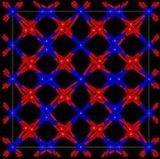
Beryllium nitride
Encyclopedia
Beryllium nitride, Be3N2, is a nitride
of beryllium
. It can be prepared from the elements at high temperature (1100–1500 °C), different Beryllium azide
or BeN6,it decomposes in vacuum into beryllium and nitrogen. It is readily hydrolysed forming beryllium hydroxide and ammonia. It has two polymorphic forms cubic α-Be3N2 with a defect anti-fluorite structure, and hexagonal β-Be3N2. It reacts with silicon nitride
, Si3N4 in a stream of ammonia at 1800–1900°C to form BeSiN2.
ceramics as well as in nuclear reactor
s and to produce radioactive carbon-14
for tracer applications.
and the corresponding salts of the acids:
In strong alkali solutions, a beryllate forms, with evolution of ammonia:
Both the acid and alkali reactions are brisk and vigorous. Reaction with water, however, is very slow:
Reactions with oxidizing agents are likely to be violent. It is oxidized when heated at 600°C in air.
Nitride
In chemistry, a nitride is a compound of nitrogen where nitrogen has a formal oxidation state of −3. Nitrides are a large class of compounds with a wide range of properties and applications....
of beryllium
Beryllium
Beryllium is the chemical element with the symbol Be and atomic number 4. It is a divalent element which occurs naturally only in combination with other elements in minerals. Notable gemstones which contain beryllium include beryl and chrysoberyl...
. It can be prepared from the elements at high temperature (1100–1500 °C), different Beryllium azide
Beryllium azide
Beryllium azide, Be2, is an inorganic compound. It is not the same as beryllium nitride, Be3N2.-Synthesis:Beryllium azide has been synthesised by the reaction of beryllium chloride with neat trimethylsilyl azide:...
or BeN6,it decomposes in vacuum into beryllium and nitrogen. It is readily hydrolysed forming beryllium hydroxide and ammonia. It has two polymorphic forms cubic α-Be3N2 with a defect anti-fluorite structure, and hexagonal β-Be3N2. It reacts with silicon nitride
Silicon nitride
Silicon nitride is a chemical compound of silicon and nitrogen. If powdered silicon is heated between 1300° and 1400°C in an atmosphere of nitrogen, trisilicon tetranitride, Si3N4, is formed. The silicon sample weight increases progressively due to the chemical combination of silicon and nitrogen...
, Si3N4 in a stream of ammonia at 1800–1900°C to form BeSiN2.
Preparation
Beryllium nitride is prepared by heating beryllium metal powder with dry nitrogen in an oxygen-free atmosphere in temperatures between 700 and 1400 °C.Uses
It is used in refractoryRefractory
A refractory material is one that retains its strength at high temperatures. ASTM C71 defines refractories as "non-metallic materials having those chemical and physical properties that make them applicable for structures, or as components of systems, that are exposed to environments above...
ceramics as well as in nuclear reactor
Nuclear reactor
A nuclear reactor is a device to initiate and control a sustained nuclear chain reaction. Most commonly they are used for generating electricity and for the propulsion of ships. Usually heat from nuclear fission is passed to a working fluid , which runs through turbines that power either ship's...
s and to produce radioactive carbon-14
Carbon-14
Carbon-14, 14C, or radiocarbon, is a radioactive isotope of carbon with a nucleus containing 6 protons and 8 neutrons. Its presence in organic materials is the basis of the radiocarbon dating method pioneered by Willard Libby and colleagues , to date archaeological, geological, and hydrogeological...
for tracer applications.
Reactions
Beryllium nitride reacts with mineral acids producing ammoniaAmmonia
Ammonia is a compound of nitrogen and hydrogen with the formula . It is a colourless gas with a characteristic pungent odour. Ammonia contributes significantly to the nutritional needs of terrestrial organisms by serving as a precursor to food and fertilizers. Ammonia, either directly or...
and the corresponding salts of the acids:
- Be3N2 + 6 HCl → 3 BeCl2 + 2 NH3
In strong alkali solutions, a beryllate forms, with evolution of ammonia:
- Be3N2 + 6 NaOH → 3 Na2BeO2 + 2 NH3
Both the acid and alkali reactions are brisk and vigorous. Reaction with water, however, is very slow:
- Be3N2 + 6 H2O → 3 Be(OH)2 + 2 NH3
Reactions with oxidizing agents are likely to be violent. It is oxidized when heated at 600°C in air.

